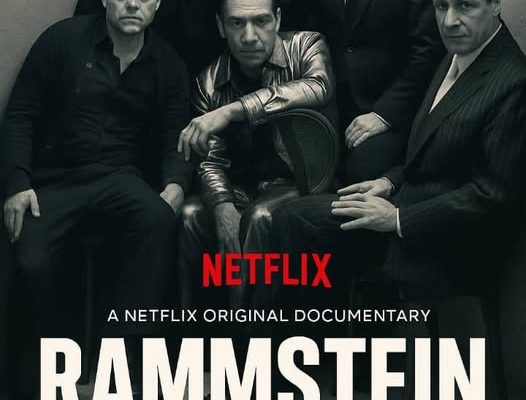For more than three decades, Rammstein has existed in a category of its own — too theatrical for traditional metal, too industrial for rock, too provocative for mainstream acceptance, yet too magnetic to ignore. They’ve been called controversial, genius, offensive, poetic, and dangerous — often all in the same sentence. Now, Netflix’s latest documentary, “Feuer und Wahrheit: The Untold Story of Rammstein”, lifts the iron curtain on the band’s mysterious world and gives fans a raw, unfiltered look at what it really means to be the most feared and fascinating band on the planet.
This is not another concert film. It’s not a nostalgic trip through albums or a tidy PR-polished biopic. It’s a visceral experience — one that captures the chaos, creativity, and conflict that have defined Rammstein since their inception. From the haunting glow of Berlin’s underground clubs in the early 1990s to sold-out stadiums bursting with fire and fury, the documentary pulls no punches. It’s bold, brutal, and beautifully honest — much like the band itself.
The film begins with grainy archival footage: a young Till Lindemann, bare-chested, drenched in sweat, performing in a tiny East German venue while a handful of stunned onlookers stare in disbelief. The crowd doesn’t quite know what they’re witnessing — part theatre, part rebellion, part madness. That’s where the story of Rammstein begins: in the ruins of post-Cold War Germany, where disillusionment met artistic hunger and industrial noise became a form of therapy.
The documentary sets the tone with interviews from band members who, for once, drop the deadpan irony and open up about their past. Guitarist Richard Z. Kruspe recalls the uncertainty of the early years: “We didn’t know if we were making music or just noise. But we knew it felt like freedom.” Drummer Christoph Schneider adds, “There was anger in everything we did — anger at the system, at ourselves, at everything we couldn’t say out loud for so long.”
From there, the film dives deep into the psychology of the band — six men bound not just by music but by a shared sense of alienation. Growing up in the East German socialist regime, they were raised under control and surveillance. Rammstein’s sound became the sonic embodiment of rebellion — mechanized, disciplined, yet violently emotional. The Netflix team juxtaposes cold, grey footage of East Berlin with the band’s later pyrotechnic spectacles, symbolizing their transformation from suppression to explosive expression.
But “Feuer und Wahrheit” is not afraid to reveal the fractures beneath the flames. One of the most riveting moments comes when the camera captures Till Lindemann alone, reflecting on fame and the cost of provocation. “People think we play with fire for fun,” he says quietly. “They don’t see the scars.” The scars are both literal and metaphorical — the toll of endless tours, personal controversies, and the moral weight of walking the fine line between art and outrage.
Netflix gives viewers unprecedented access to behind-the-scenes footage that has never been seen before. Rehearsals turn into philosophical debates. Arguments over stage design escalate into near-physical confrontations. There’s laughter, but also exhaustion. The documentary doesn’t paint Rammstein as rock gods — it shows them as craftsmen obsessed with perfection, willing to bleed for their art.
One particularly intense sequence follows the creation of their infamous stage performances. The crew is seen testing flamethrowers and pyrotechnic devices under Till’s watchful eye. The sound engineers discuss the calculated synchronization of fire, sound, and emotion. “We want people to feel something they’ve never felt before,” says Kruspe. “If they’re scared, that’s fine. If they cry, even better. But they should never feel nothing.”
And yet, “Feuer und Wahrheit” doesn’t shy away from addressing the controversies that have followed the band like a shadow. From accusations of glorifying violence to debates about sexual imagery and political symbolism, Rammstein has always been a lightning rod for criticism. The documentary handles these issues with striking maturity. It doesn’t defend the band — it lets them explain themselves.
“We are not politicians,” Schneider insists in one scene. “We are artists. We hold up a mirror. If people don’t like what they see, that’s not our fault.” The filmmakers intercut this with archival footage of protests outside Rammstein concerts, moral outrage from pundits, and fan testimonials from across the world. Some call them dangerous. Others call them revolutionary. The truth, the documentary suggests, might be somewhere in between.
The narrative also digs into the band’s unique dynamic — a democracy held together by conflict. Each member contributes equally to the songwriting process, and decisions are made collectively, sometimes painfully so. Keyboardist Christian “Flake” Lorenz jokes, “We fight more than we play. But maybe that’s why we’re still here.” The film shows that this constant tension — between control and chaos, intimacy and distance — is the secret ingredient of Rammstein’s longevity.
Netflix weaves these personal confessions with stunning visuals: massive live performances shot in 8K, intimate handheld clips from backstage, and cinematic recreations of pivotal moments in the band’s history. The editing mirrors Rammstein’s own music — rhythmic, aggressive, hypnotic. The sound design deserves special mention, layering classic Rammstein riffs with ambient industrial noise and haunting whispers from Lindemann’s poetry readings.
One of the film’s most emotional sections explores Lindemann’s other passion: writing. His poetry, often overshadowed by his monstrous stage persona, becomes a key to understanding his artistry. “On stage, I scream,” he says. “In poems, I whisper.” Through this juxtaposition, the documentary humanizes him, showing the sensitivity beneath the armor of provocation.
Of course, no Rammstein story is complete without addressing their relationship with fire — their defining symbol. The film dedicates an entire chapter to the psychology of pyrotechnics. The crew explains how every flame is choreographed to express emotion — not just spectacle. Fire becomes a metaphor for purification, destruction, and rebirth. The documentary even includes haunting slow-motion footage of flames licking Lindemann’s face as he performs “Mein Teil,” turning danger into poetry.
But what makes this film truly groundbreaking is how it explores the band’s relationship with its audience. Rammstein’s fans — diverse, loyal, and sometimes obsessive — are given a voice throughout the documentary. From a Mexican fan who tattooed lyrics across his back to a German soldier who claims the band’s music saved his life, the testimonies reveal how Rammstein transcends language and culture. Their concerts, the film argues, are not just performances but communal rituals — where aggression turns to catharsis and taboo becomes truth.
Netflix’s decision to produce “Feuer und Wahrheit” feels like both a risk and a revelation. Documentaries about rock legends often sanitize their subjects or drown in nostalgia. This one refuses to do either. Instead, it strips away myth without killing the magic. It shows that Rammstein’s greatest act is not their use of fire, but their refusal to be tamed by it.
Toward the end, the documentary becomes almost philosophical. The members, older now, reflect on mortality, legacy, and what comes after the fire burns out. “We are not forever,” Lindemann admits. “But maybe the feeling we create — that is.” His words hang in the air as footage of the band performing “Sonne” plays over slow-motion pyrotechnics and a sea of fans chanting in unison. It’s a moment of transcendence — beauty born from chaos.
When the credits roll, one thing is clear: “Feuer und Wahrheit” isn’t just a documentary about a band. It’s a story about art’s power to disturb, to heal, and to set the world ablaze. Rammstein has always lived on the edge of danger — musically, morally, and emotionally — and Netflix’s portrayal captures that raw essence without compromise.
You leave the film feeling both exhausted and exhilarated, as if you’ve just witnessed something forbidden yet necessary. You understand that Rammstein isn’t merely about shock value or spectacle. They are storytellers of darkness, chroniclers of contradiction, and proof that sometimes the most dangerous art is the most honest.
In the end, Netflix doesn’t just show us Rammstein. It forces us to confront the questions they’ve been asking for decades: Where does art end and provocation begin? Can pain be beautiful? Can danger be divine?
“You’ve never seen Rammstein like this before,” the trailer promises — and it’s true. You’ve seen the flames, the fire, the fury. But now, for the first time, you see the truth behind it all — and it burns even brighter than the pyrotechnics ever could.



